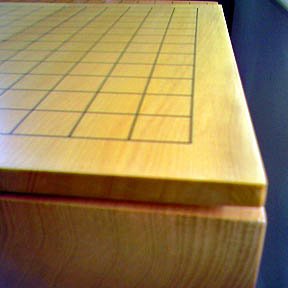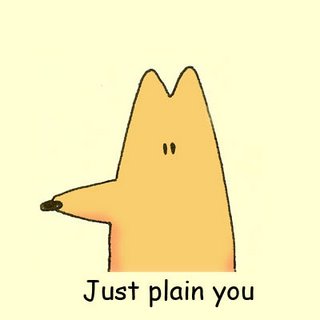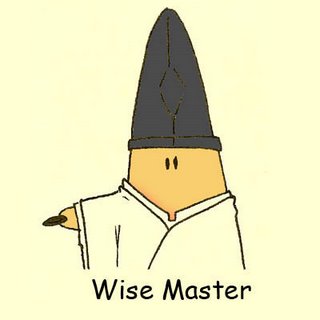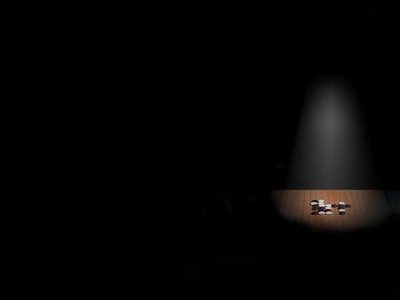
I was a bit shocked when I was told that a friend on one of the servers had
"quit" Go. As it was explained to me, he was feeling frustrated with his lack of progress and had encountered a long string of recent losses.
I can sympathize. There were a few moments back in January when I was questioning my ability to advance and that, perhaps, I should just give up. I pondered the possibility that I was a lifetime 20k.
Except for the more talented, many of us probably will hit walls on our way to to the dan ranks. Kageyama-sensei warns of these walls in his book,
Lessons In The Fundamentals of Go.
chrono3450 told me that he experienced walls on KGS every three ranks after 20-kyu. The comments and emails that I had received after one of my posts suggests that it is more the norm, than the exception, to encounter a wall on KGS at 18-19 kyu.
Unrealistic expectations of rapid advancement can further fuel frustrations. Some of us set goals which are too aggressive given our beginning abilities, our learning resources, and the honest amount of time that we can dedicate to studying the game.
Last year, I had told
yoyoma that I was disappointed with how my progress had slowed after I got to 22-kyu. He reminded me that I am NOT
Shindou Hikaru.
Very true. I am not "the chosen one" with a latent talent for the game. I don't have a
ghost to teach me 24/7. I don't have much time in the day to dedicate to Go. My life story is not a fictional piece being written by
Yumi Hotta.
My eight-and-a-half months of experience with this game has taught me that Go is no different than any endeavour that demands determination, discipline and time - which pretty much is a reflection of life in general. Success can be accelerated by miscellaneous gifts of fortune but, for the greater majority, success is the result of piling effort upon effort.
Thankfully, as amateurs, this game is a passion but not our livelihood. We dedicate to it as much discretionary time as we have; or as much as we can steal. It's our decision to stay with it or to leave it as our life circumstances suit us. We can push forward with our Go development or, if life demands, we can
tenuki and play elsewhere.
I imagine that amateurs all have rather diverse reasons for having gotten into, and stuck with, this game. For some of us, it's become a small proving ground for our wills; a micro-arena of life. For others, it remains purely a form of recreation or, at worst,
an opiate.
Going back to my friend, it seems that he only went on a two-month sabbatical from the game; as have a few other Go players that I know.
Interestingly, time away from Go can have two diverging effects. Often, one returns to the game a bit weaker than when they left. In other cases, one returns to the game stronger. I have actually seen two cases of the latter.
Quit? You know, once I was thinking of quitting when I was diagnosed with brain, lung and testicular cancer all at the same time. But with the love and support of my friends and family, I got back on the bike and won the Tour de France five times in a row. But I'm sure you have a good reason to quit. So what are you dying of that's keeping you from the finals?
- Lance Armstrong in a cameo appearance on Dodgeball
Product Review: 9x9/13x13 combo board from YMI The combo board atop my Chinese kaya goban. Note the color difference.
The combo board atop my Chinese kaya goban. Note the color difference. My replacement
9x9/13x13 combo board arrived from
Yellow Mountain Imports last Monday but I didn't have the free time to write-up this review until this weekend.
The first board
arrived warped. I tried to unwarp it by weighting down the center, to no avail. Thankfully, YMI sent me the replacement only two days after I had contacted them via email about the problem. The new board arrived along with a return waybill so I didn't have to pay return shipping. I just re-packed the old board and dropped it off at the freight carrier's local office.
 Here's the 9x9 surface. I added silicone pads to the corners.
Here's the 9x9 surface. I added silicone pads to the corners.The total cost for this board, including shipping, handling and California state sales tax was $20.42. The board measures 35cm x 33cm x 1cm. It seems to be constructed of 7 pieces of wood. The top and bottom are covered with a thin veneer so as to make the playing surfaces look like one solid piece of wood.
 The veneer playing surfaces make the board look like it is one
The veneer playing surfaces make the board look like it is one
solid piece.
As you can see from the photos, the color of this board is more honey-like compared to the cinnamon shade of
my kaya goban. I added 10mm clear silicone pads to the corners of both sides to help protect the smooth matte playing surfaces. There's a very generous 2.5cm clearance between the edge of the 13x13 grid and the edge of the board so the pads don't come into contact with any stones placed on the corners.
 Click to enlarge and you'll see minor imperfections in the grid lines.
Click to enlarge and you'll see minor imperfections in the grid lines.
See the wide distance between the silicone pad and the corner
of the 13x13 grid?
As was revealed from the
photo-tour of the Yunnan Weiqi Factory, the grids are typically drawn on by hand and not silk-screened. I found indicators of this method when closely inspecting this board; a tiny smudge here, a slight overlap of the lines there. None of these were noticeable at a normal viewing distance and I can't call them dissatisfiers.
Because the board is just 1cm thick, it doesn't give as solid a sound when a stone is placed on the surface; particularly with the silicone pads in place. The sound is more of a hollow
"tok" than a sharp
"tak". That was expected.
 I had re-oiled my Yunzis about two weeks ago. This season'sscent is Lemon-Basil.
I had re-oiled my Yunzis about two weeks ago. This season'sscent is Lemon-Basil.Overall, I'm very satisfied with the value-for-money of this board and with YMI's prompt customer service. This board strikes me as a good balance between utility and good looks at under $21 shipped.
The combination of my kaya set and this combo board provides me with almost all of the gear that I need for in-person games. I just need to find a game timer and some sort of padded bag that might carry
both the 19x19 and combo boards without scuffing the surfaces or edges.
Two alternatives to consider would be:
- Samarkand's 1-inch hiba board (made in Korea) which sells for $45 (excluding shipping and handling which was $10.25 for Northern California). The thickness of this board means that it is less likely to warp. Its thickness may also add to its aesthetic appeal.
- Yutopian's 0.5-inch Agathis board (made in Japan) which sells for $25.00 (excluding shipping and handling of $6.50). No photo is available for this board but it seems to ge a good price.
Fuseki Quiz 2/20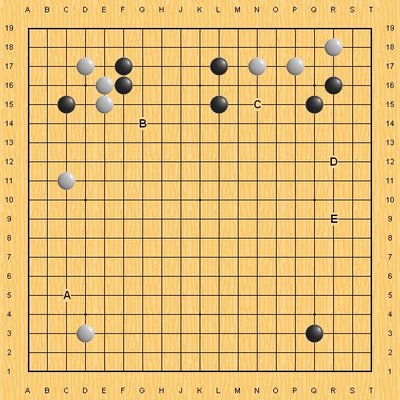 Black to Play. I chose "E".
Black to Play. I chose "E".It helps to look at the board from your opponent's perspective.
Scoring of Last Weekend's Fuseki Quiz 1/20- A = 2
- B = 6
- C = 8
- D = 4
- E = 10, Attacks the R10 stone & secures the upper right corner. If W does not respond, capping the R10 stone with a B stone on P10 eclipses all of W's prospects in that area.
In other newsWell, my global conference concluded with positive reviews. My thanks to all of you who expressed your support!
Sadly, our administrator passed on to me a rumor that a layoff is in the works at our corporation. It would supposedly impact 18% of the workforce; almost 1 out of every 5 employees. She's 80% accurate with regards to these types of rumors.
Our department survived five layoffs with a loss of only one employee but it's always disturbing to hear these plans. The axe is expected to fall this summer after the fiscal year closes.
The rumor has probably been released to encourage attrition. As a contingency, I'll be investigating job opportunities at other companies over the next three months. This is an example of life forcing us to
tenuki. That will take time away from Go and from blogging.
Wish me luck!
 For almost a full five months, Pong Yen at Yellow Mountain Imports had been hinting of a new product coming on the horizon. I suspected that it might be a new bag for carrying Go equipment and I was right. Pong was kind enough to share with me the first public images of YMI's new GoBox.
For almost a full five months, Pong Yen at Yellow Mountain Imports had been hinting of a new product coming on the horizon. I suspected that it might be a new bag for carrying Go equipment and I was right. Pong was kind enough to share with me the first public images of YMI's new GoBox. You can see the pre-cut foam inserts to hold the board, the bowls, and perhaps a timer. According to the specs that were provided to me, the GoBox will accomodate boards up to 6cm thick and bowls as big as the wider Go Seigen style.
You can see the pre-cut foam inserts to hold the board, the bowls, and perhaps a timer. According to the specs that were provided to me, the GoBox will accomodate boards up to 6cm thick and bowls as big as the wider Go Seigen style.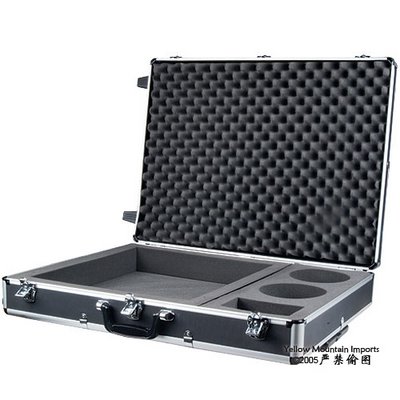 Photographers will recognize this case design. It's similar to those from Hakuba, Pelican or Mamiya which are used to transport expensive photo gear when travelling. Obviously, the GoBox is meant to transport expensive full-sized table gobans and protect them from damage. As many of us know, Kaya and Spruce are soft woods.
Photographers will recognize this case design. It's similar to those from Hakuba, Pelican or Mamiya which are used to transport expensive photo gear when travelling. Obviously, the GoBox is meant to transport expensive full-sized table gobans and protect them from damage. As many of us know, Kaya and Spruce are soft woods. According to Pong, the GoBox is constructed of ABS material and it has travel locks in its latches. These photos suggest that it might be sturdy enough to withstand the tortures of checked-in luggage but I may have to assess that for myself when I can get my hands on one.
According to Pong, the GoBox is constructed of ABS material and it has travel locks in its latches. These photos suggest that it might be sturdy enough to withstand the tortures of checked-in luggage but I may have to assess that for myself when I can get my hands on one. Here's the kicker-feature. The GoBox is mobile! It has a built-in pair of transport wheels and a retractable pull-handle similar to those of modern travel luggage and laptop carriers. This makes sense when you consider the total weight of a full-sized goban, bowls and stones.
Here's the kicker-feature. The GoBox is mobile! It has a built-in pair of transport wheels and a retractable pull-handle similar to those of modern travel luggage and laptop carriers. This makes sense when you consider the total weight of a full-sized goban, bowls and stones.
















